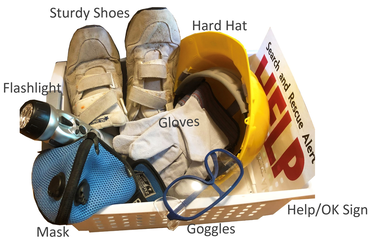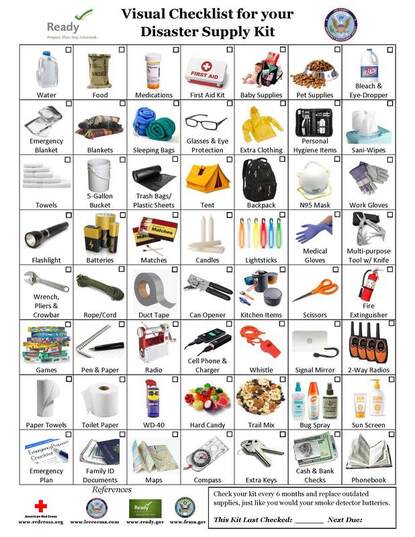|
Family Prep
Pack Go Bags & Kits Stay Informed Family Emergency Plan Store Water & Supplies Sanitation & Hygiene Store Food for Cooking Eliminate Home Hazards What Can't you live Without? Put it in your Go Bag Now. |
Go Bags & Emergency KitsIn a disaster, you may have to evacuate rapidly. It's important to have your emergency supplies packed and ready to go. In this Neighbors Ready! QuakeUp! video, you’ll learn about the 3 evacuation levels so you’ll know when to leave during an evolving emergency, and how to organize your emergency supply kits to make sure you have what you need and are ready to go. We'll provide lists with suggestions on what to include, and we'll discuss how to pack your bags efficiently. We’ll talk about three different types of kits: under-bed kits, go bags (for 1 - 2 days), and evacuation kits (for 3 days - 2 weeks). Scroll down to find additional resources for further research, including a transcript of the presentation with speaker notes.
|

|
Disasters can strike at any time. Go bags, or bug-out bags, contain items you need to help you stay safe no matter where you are, with supplies for a minimum of 1-2 days. Your go bag should:
Check out this video: Trish Reading, our go bag expert, shares what she packs in her bag and why. |
|
Evacuation kits provide supplies and tools to help you survive for a longer duration, such as 3 days to 2 weeks. Evacuation kits build on the supplies you've packed in your go bags. During an evacuation, you may need to go to a shelter or a friend's home, for days, weeks, a month. Here's a minimum list:
|
|
Many people organize their go bags and evacuation kits using off-the-shelf school backpacks. But with only one compartment, all your stuff is dumped in, making it hard to find what you need in a hurry. Locating what you need involves wading through layers and layers of stuff, and supplies on the bottom get crushed.
Organize supply groups One way to better organize your supplies is to use clear cubes or ziplock bags to organize different types of supplies together. For example, if you store all of the things that could expire together, it'll make the job of refreshing your evacuation bag much easier. |
 Click image to view Visual Checklist for Disaster Supplies.
Click image to view Visual Checklist for Disaster Supplies.
|
Cedar Hills Ready! go bag checklists. You'll also find these lists in our "Get Prepared Now!" booklet, along with a lot more tips and information to help you get prepared.
|

|
Fire & Evacuation: Oregon Ready Set Go. Sign up for TVF&R alerts. Know when to evacuate and what to do before you must go. Attend a Ready Set Go Webinar. Learn about the fire risk for your home and neighborhood, and how to prepare your home to reduce wildfire risk.
|
|
Prep Tips for Seniors & Special Needs
|
